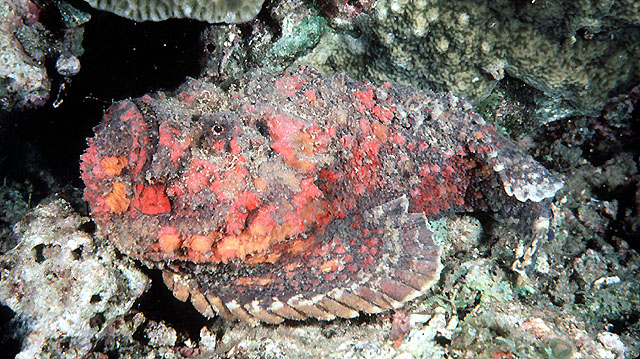| Synanceiidae (Stonefishes), subfamily: Synanceiinae |
| 40 cm SL (male/unsexed); max.weight: 2,400.0 g |
|
reef-associated; marine; depth range 0 - 30 m, non-migratory |
| Indo-Pacific: Red Sea and East Africa to French Polynesia, north to the Ryukyu and Ogasawara islands, south to Queensland, Australia. |
|
Dorsal spines (total): 12-14; Dorsal soft rays (total): 5-7; Anal spines: 3-3; Anal soft rays: 5-6. Colors matching surroundings and extremely well-camouflaged (Ref. 48635). Pelvic and anal fins spines are similarly developed. 12-14 stout grooved spines, each with a large venom sack at its base (Ref. 37816).
Description: Characterized by having almost equally sized dorsal spines; large and fleshy pectoral fin; broad and depressed head; relatively small and widely separated eyes, directed upward; dorsal mouth opening, vertical gape; depth of body about 2.5 in SL (Ref. 90102). |
| Most widespread stonefish (Ref. 4313). Found on sandy or rubble areas of reef flats and shallow lagoons and in small pools during low tide well camouflaged among the substrate and sometimes even covered with algae (Ref. 5213, 5503). Solitary species (Ref. 37816). Feeds on fishes and crustaceans. The dorsal fin has 2 grooves serving as seringes of venom; their stings are excruciatingly painful and can occasionally be fatal. A serum exists which is effective if applied immediately after the infliction. World's most venomous fish (Ref. 37816). Uncommon in markets. In Hong Kong live fish markets (Ref. 27253). Also Ref. 57406. |
|
Least Concern (LC); Date assessed: 20 June 2017 Ref. (130435)
|
| venomous |
Source and more info: www.fishbase.org. For personal, classroom, and other internal use only. Not for publication.
